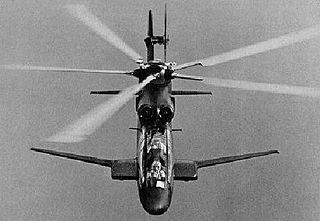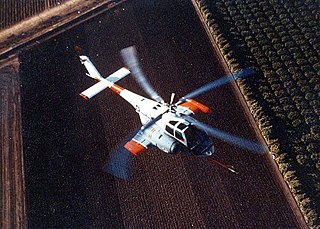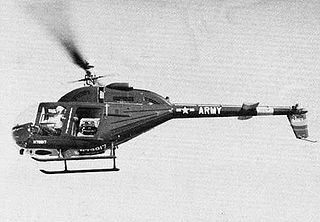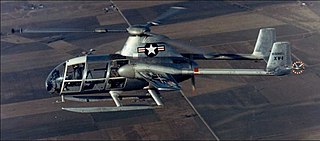
The Sikorsky CH-37 Mojave is an American large heavy-lift helicopter of the 1950s.

The Bell XV-15 is an American tiltrotor VTOL aircraft. It was the second successful experimental tiltrotor aircraft and the first to demonstrate the concept's high speed performance relative to conventional helicopters.

The Bell X-22 is an American V/STOL X-plane with four tilting ducted fans. Takeoff was to selectively occur either with the propellers tilted vertically upwards, or on a short runway with the nacelles tilted forward at approximately 45°. Additionally, the X-22 was to provide more insight into the tactical application of vertical takeoff troop transporters such as the preceding Hiller X-18 and the X-22's successor, the Bell XV-15. Another program requirement was a true airspeed in level flight of at least 525 km/h.

The Sikorsky S-67 Blackhawk was a private-venture, prototype attack helicopter built in 1970 with Sikorsky Aircraft research and development (R&D) funds. A tandem, two-seat aircraft designed around the dynamic drive and rotor systems of the Sikorsky S-61, it was designed to serve as an attack helicopter or to transport up to eight troops into combat.

The Hiller VZ-1 Pawnee was a unique direct-lift rotor aircraft, using contra-rotating ducted fans for lift inside a platform upon which the single pilot shifted body weight for directional control. The platform was developed starting in 1953 under an Office of Naval Research (ONR) contract to Hiller Aircraft, and flew successfully beginning in 1955.

The Hiller OH-23 Raven is a three-place, military light observation helicopter based on the Hiller Model 360. The Model 360 was designated by the company as the UH-12, which was first flown in 1948.

The Hughes XH-17 "Flying Crane" was the first helicopter project for the helicopter division of Hughes Aircraft Company. The XH-17, which had a two-bladed main rotor system with a diameter of 134 feet, still holds the world record for flying with the largest rotor system. It was capable of flying at a gross weight of more than 50,000 pounds (23,000 kg), but proved too inefficient and cumbersome to be mass-produced beyond the prototype unit.

The Bell XV-3 is an American tiltrotor aircraft developed by Bell Helicopter for a joint research program between the United States Air Force and the United States Army in order to explore convertiplane technologies. The XV-3 featured an engine mounted in the fuselage with driveshafts transferring power to two-bladed rotor assemblies mounted on the wingtips. The wingtip rotor assemblies were mounted to tilt 90 degrees from vertical to horizontal, designed to allow the XV-3 to take off and land like a helicopter but fly at faster airspeeds, similar to a conventional fixed-wing aircraft.

The Lockheed XH-51 was an American single-engine experimental helicopter designed by Lockheed Aircraft, utilizing a rigid rotor and retractable skid landing gear. The XH-51 was selected as the test vehicle for a joint research program conducted by the United States Army and United States Navy to explore rigid rotor technology.

The Sikorsky S-72 was an experimental compound helicopter developed by helicopter manufacturer Sikorsky Aircraft.

The Sikorsky S-69 is an American experimental co-axial compound helicopter developed by Sikorsky Aircraft as the demonstrator of the Advancing Blade Concept (ABC) under United States Army and NASA funding.

The Fairchild Hiller FH-1100 is a single-engine, single two-bladed rotor, light helicopter designed and produced by the American aircraft manufacturer Fairchild Hiller.

The Bell YOH-4 was a single-engine, single-rotor light helicopter, developed for the United States Army's Light Observation Helicopter program. While the YOH-4A was unsuccessful in the original LOH competition, Bell redesigned it as the sleek Bell 206A JetRanger for the commercial market, and enjoyed instant and lasting success. In 1967, the Army reopened the LOH competition, and the 206A-based OH-58 Kiowa was selected.

The Piasecki VZ-8 Airgeep was a prototype vertical takeoff and landing (VTOL) aircraft developed by Piasecki Aircraft. The Airgeep was developed to fulfill a U.S. Army Transportation Research Command contract for a flying jeep in 1957. The flying jeep was envisioned to be smaller and easier to fly than a helicopter.

The Seibel S-4 was a two-bladed, single-engine helicopter built by Seibel Helicopter. Designed by Charles Seibel, the S-4 was evaluated by the United States Army under the designation YH-24 Sky Hawk, but would be rejected for service. The S-4B would serve as the basis for the design of the Cessna CH-1 Skyhook, the only helicopter Cessna ever produced.

The McDonnell XV-1 is an experimental Convertiplane developed by McDonnell Aircraft for a joint research program between the United States Air Force and the United States Army to explore technologies to develop an aircraft that could take off and land like a helicopter but fly at faster airspeeds, similar to a conventional airplane. The XV-1 would reach a speed of 200 mph, faster than any previous rotorcraft, but the program was terminated due to the tip-jet noise and complexity of the technology which gave only a modest gain in performance.

The Firestone XR-9, also known by the company designation Model 45, was a 1940s American experimental helicopter built by the Firestone Aircraft Company for the United States Army Air Forces. Only two were built.

The Sikorsky XH-39, developed by Sikorsky Aircraft in 1954, was the U.S. Army's first turbine-powered helicopter. It was fast and innovative, but ultimately rejected by the United States Army in favor of the Bell UH-1 Iroquois.

The Piasecki H-16 Transporter was a tandem-rotor transport or rescue helicopter designed by Frank Piasecki and built by Piasecki Helicopter. The prototypes were evaluated by the United States Air Force and Army, but the crash of the second test aircraft led to cancelling the project.
The McDonnell 120 Flying Crane, also V-1 Jeep, was a lightweight utility flying crane helicopter designed and built by the McDonnell Aircraft Corporation during the 1950s. The open frame fuselage supported the three gas-producers and main rotor mast, with a small single-seat cockpit in the nose, which was originally open, but later enclosed.




















